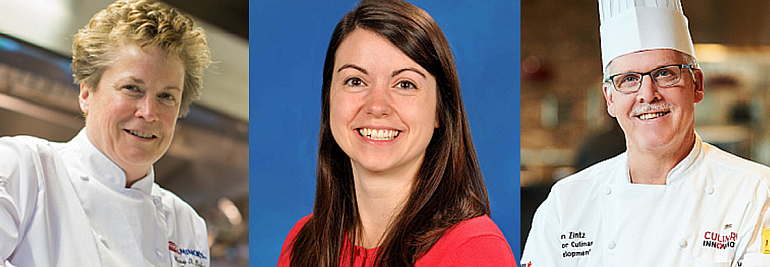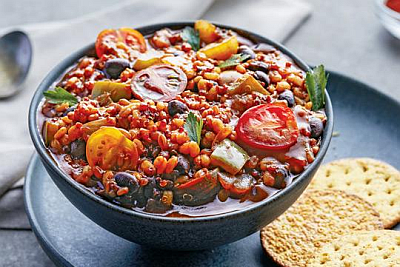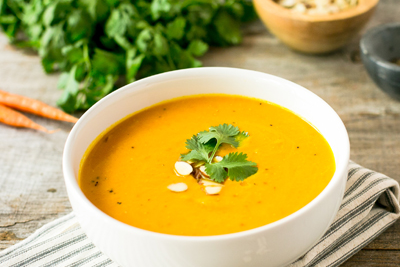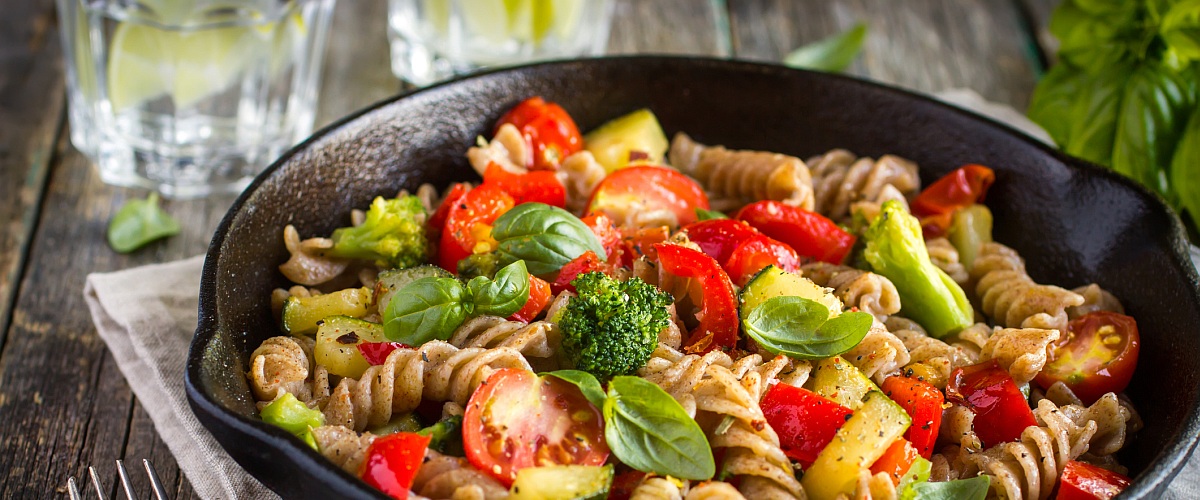Ahh, comfort foods! Whether your go-to is meatloaf, mac ’n cheese, or chicken and dumplings—these dishes satisfy like no other. Chances are, you love to make them at home (or order them for Friday night take-out).
Most comfort foods have a few things in common. They’re hot and hearty, rich and filling … and probably not very healthy. That’s because of another trait: Comfort foods tend to be loaded with ingredients like meat, cheese and cream.
So if, like many people, you’re trying to be healthier, there’s another way to do comfort food. Our partners at Nestlé Professional, whose chefs work with ours, and Aramark Chef Tim Zintz, talked with us about adapting tried-and-true comfort foods to be more plant-forward. Read on for their advice.

PLANTING THE SEEDS
If you’re intimidated by the term “plant-forward,” don’t be. It simply means putting more plants—foods like vegetables, fruits, whole grains, nuts, and legumes—at the center of your plate. Studies show that this style of eating benefits both our bodies and the planet.
“With plant-forward, you’re celebrating plants and what they can do for your wellbeing,” says Cassie Hoover, a Nutrition, Health & Wellness Manager with Nestlé Professional.
It can mean using less meat than you did before, or none at all. “In this day and age, plant-forward means different things to different people. You don’t need to follow a completely vegetarian or vegan diet,” notes Nestlé Professional Corporate Chef Mary Locke. “Follow what is right for you and your family, no matter what you’re cooking.”
If you’ve tried to eat more plant-forward, you may have noticed the dishes can be just as gratifying as those centered around meat or full fat dairy products. That means that, with a plant-forward makeover, the rich comfort foods you know and love can be much better for you—and still stick to your ribs.
“From a nutrition perspective, protein and fiber are what make us feel full after a meal. You can definitely get that from plants!” Cassie reassures us. Done right, the flavors and textures of more plant forward comfort foods can be just as delicious and satisfying. Think of the richness of grains, beans and nuts coming together with the subtle sweetness of tomatoes, onions and squash–all plant ingredients, covering a full range of flavors for a healthy and tasty bite.

COMFORT FOODS, REIMAGINED
Cassie and Chef Mary have lots of ideas to make your favorite comfort food recipes more plant-forward and healthier.
Play to your strengths: For example, if you’re famous for making pizza dough, top your crust with new veggie combos. Traditional soups and casseroles have many ingredients, making them ripe for plant-forward experimentation. “Stick to your comfort zone instead of tackling a brand-new recipe. Otherwise, you might get discouraged,” says Chef Mary.
Mind the taste and texture: Recipe revamping works best when the new ingredient resembles what it’s replacing (at least somewhat). That’s why umami-packed mushrooms can fill in for meat and why cauliflower rice is a jack of all trades. “You want something that feels and tastes similar if not better!” explains Cassie.
Start small: This is classic ingredient-swapping advice. Cassie recommends changing one thing at a time—like cutting back on the meat or the cheese in Grandma’s lasagna, but not both. Cassie’s a fan of using eggplant instead of ground beef. “Start with 10 percent of the chosen ingredient, see how you like it, then ramp up from there,” she says. Even Chef Tim starts the plant-forward change with small, incremental updates: “I use a progressive approach, making subtle adjustments as I work through a recipe.” You’re in good company with this technique!
Add a little extra: When in doubt, add another vegetable. From pumpkin in your chili to zucchini in your meatloaf, there are easy ways to add volume, nutrients, and layers of flavor. “It’ll be just enough to make your family say, ‘Hey, what is that something extra?’” shares Chef Mary.

Focus on the presentation: Going plant-forward doesn’t have to upend your entire comfort food routine. Say you’re grilling portobello mushroom caps in place of hamburgers. For maximum appeal, prepare that burger the way you normally would—toasted bun, condiments, and all. “People eat first with their eyes, so a familiar plating helps with the perception,” adds Chef Mary. Chef Tim emphasizes that point by noting that, if you present the dish in a unique way, “they usually won’t notice there is less protein or that there is something ‘missing.’”
Put it out there: Instead of passing off your new creation as the same old, celebrate its healthier merits. “Focus on what you’re eating, not what’s been left out. Share what you’ve changed and why,” Cassie advises. “The more people are exposed to plant flavors and textures, the more they’re going to like them. This is true for both kids and adults.”
10 SWAPS TO SAVOR
Here are Cassie and Chefs Mary and Tim’s top plant-forward swaps, sure to match any comfort food you’re craving. Even better, our partners at Nestlé have suggested some recipes to go with them!
- Baked Goods: Canned pumpkin or applesauce can replace half the fat ingredients (butter, eggs, oil) in your cookies, breads, and muffins. Try: Pumpkin Chocolate Brownies.
- Burgers and Meatballs: Mix cooked grains or diced eggplant and mushrooms into your patties. Or check out the many meat substitutes at your local store.
- Chili: Reduce the ground meat and double down on the beans for extra fiber.Hearty grains can also hit the spot.Try: 3-Grain Chili.
- Creamy Dips and Sauces: Trade some of the high-fat dairy in an alfredo sauce for pureed cauliflower. Try: Nestlé’s dairy-free Cauliflower Buffalo Dip with cooking almond milk!
- Lasagna: Sliced or diced eggplant can easily replace some of the meat in this crowd-pleaser.
- Macaroni and Cheese: Cauliflower florets can take the place of half the pasta, with a texture that blends right in.
- Meatloaf: Use shredded zucchini or carrots to replace up to 20% of the meat ingredients (especially because vegetables have a higher water content).
- Rice: On its own or in a recipe, cauliflower rice is up to the challenge. You’ll find this convenient product in nearly every grocery store, or you can make it yourself.
- Soups, Stews, and Curries: It’s easy to add vegetables like pumpkin and sweet potatoes to these one-pot wonders. Try: Roasted Carrot, Ginger and Almond Soup or Curry Brown Rice Bake with Vegetables. Chef Tim also reminds us of one of his favorite tricks. When soup recipes require a roux (a mix of flour and butter or oil to help thicken sauces), use potato as a thickener instead.
- Tacos: Mushrooms and beans are a great alternative or accompaniment to ground meat.

FAST FORWARD
With a few tweaks, you can enjoy your favorite comfort foods re-crafted to be better for you and the planet—thanks to the power of plants. “The sky is the limit,” shares Chef Tim. “One point we discuss when creating these recipes is there aren’t any rules. Lean into your creativity and you’ll be just fine!”
Chef Tim adds, “As you move to a more plant-forward approach to comfort foods (and other favorites), you’ll get the added comfort of knowing you’re preparing food that’s better for your health—and our environment.” Plant-based ingredients result in fewer greenhouse gas emissions and reduced demand for water and land resources—a small but important step we can all take to help preserve our planet.
“It’s an approach we’re taking on our menus,” says Chef Tim, noting that more than 30 percent of the main dishes we’re serving in cafes around the country are now vegan or vegetarian. In addition, Aramark’s team of chefs has created over 300 new plant-based recipes, which has had the effect of reducing the amount of red meat in the recipes we serve by more than 10 percent on average.
Where will you start experimenting with plant-forward comfort foods? Try Nestlé’s takes, plus many more in our recipe section!
Note: Since everyone’s health history and nutritional needs are so different, please make sure that you talk with your doctor and a registered dietitian to get advice about the diet and exercise plan that‘s right for you.

